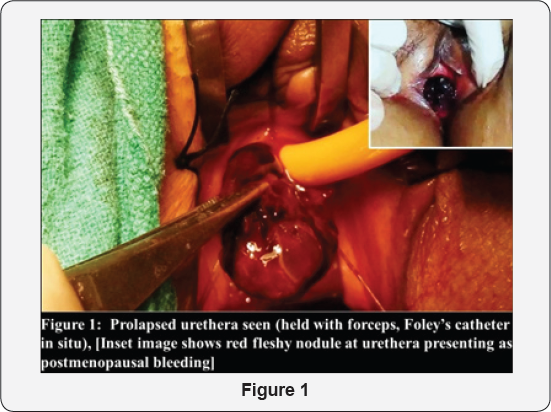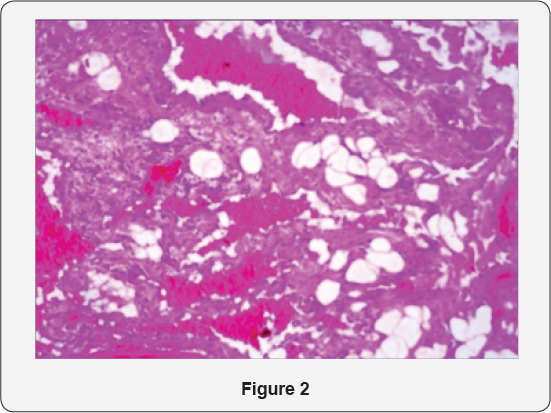Strangulated Uretheral Prolapse in a Postmenopausal Woman Mimicking As Malignancy; a Case Report
Manupriya Sharma1*, Som Raj Mahajan2, Rashmi Raina1 and Anjali Soni3
1Department of Pathology, DR RPGMC, India
2Department of General Surgery, DR RPGMC, India
3Department of Obstetrics & Gynecology, DR RPGMC, India
Submission: September 18, 2017; Published: September 25, 2017
*Corresponding author: Manupriya Sharma, Department of Pathology, DR RPGMC, Kangra HP, India, Tel: 91-8628000105; Email: manupriya.priyasharma@gmail.com
How to cite this article: Manupriya Sharma, Som Raj Mahajan, Rashmi Raina, Anjali Soni,Strangulated Uretheral Prolapse in a Postmenopausal Woman Mimicking As Malignancy; a Case Report. JOJ Nurse Health Care. 2017; 4(4) 555644. DOI: 10.19080/JOJNHC.2017.04.555644
Abstract
Uretheral prolapse (UP) in a postmenopausal woman is a rare occurrence. As the size of UP increases it undergoes strangulation. This presentation being uncommon can be mistaken as malignancy especially keeping in view the age of the patient. High index of clinical suspicion, simple excision and confirmation of diagnosis with histopathology examination, is the mainstay of diagnosis and treatment. Long term vaginal estrogen cream should be used. We hereby report a case of strangulated UP in a postmenopausal woman, so as to make the managing physicians aware regarding this uncommon diagnosis and remove avoidable anxiety to patients and physicians. It is prudent to mention the role of histopathology in final confirmation of diagnosis so as to rule out more sinister diagnosis e.g. uretheral or vaginal malignancy, rhabdomyosarcoma or even endodermal sinus tumor.
Introduction
Uretheral prolapse (UP) is eversion of uretheral mucosa through the external uretheral meatus. It has been reported to have bi-modal age distribution at extremes of age; with preponderance in prepubertal girls (80%) as compared to postmenopausal women [1]. It has an estimated incidence of 1:3000 in prepubertal girls. However, the exact incidence in postmenopausal women is unknown and only limited case reports (46 cases) have been reported till date [2,3]. Even in postmenopausal women, it is more common in white women (almost exclusively). Furthermore strangulation in UP is even rarer [4]. We hereby report a case of strangulated UP in a 58-year- old postmenopausal black woman which was erroneously suspected as uretheral carcinoma.
Case Report
A 58-year-old postmenopausal woman reported to the emergency room with a history of one episode of postmenopausal bleeding. She also complained of supra-pubic pain & dysuria for last two weeks. She had attained menopause 12 years back. She also reported awareness of a red fleshy mass at the introitus for which she had sought consultation at a rural health centre where she was suspected of uretheral carcinoma and was referred to this institute. There was no history of trauma to genitalia. She had previous six vaginal deliveries. Her medical history was unremarkable. On examination her vitals were within normal limits. Her genitourinary examination was remarkable with a red fleshy mass 3 centimeter in diameter at the introitus. On closer inspection actually it was uretheral mucosa which was donut shaped, prolapsed, and congested (Figure 1). There was no palpable cystocele or rectocele. A Foley's catheter was introduced and circumferential prolapsed uretheral mucosa was confirmed. The pelvic examination was normal. With a provisional diagnosis of strangulated UP the patient was brought to the operating room.
The prolapsed mass was dissected using four quadrant technique. After application of holding sutures in four quadrants, the prolapsed mucosa was cut and anastomosis was performed with mucosa. The specimen was sent for histopathology examination. The histopathology examination revealed ulcerated polypoidal tissue composed of fibro-vascular stroma with dilated and congested vessels. Mucosal edema and moderate lymphoplasmacytic infiltrate was also seen (Figure 2). There was no evidence of malignancy. Patient was discharged in healthy condition on fifth post-operative day after removal of urinary catheter. She was advised vaginal estrogen cream. Till date she is on regular follow up and do not have any recurrence of symptoms.


Discussion
Vaginal bleeding is a relatively common presenting complaint in postmenopausal women. However, UP presenting as vaginal bleeding is a rare occurrence. Furthermore, our patient had strangulation of the UP and was erroneously suspected as uretheral carcinoma by the primary physician. UP is a very rare occurrence in postmenopausal women with limited cases reported till date (46 cases only) [1-4]. Even though UP has a typical appearance of erythematous bright red or dark & cyanotic, inflamed mucosa protruding from the external urethral meatus (donut shaped) still the diagnosis is not so straight forward. Patients clinically suspected as UP, have been confirmed to have varied diagnosis ranging from benign forms such as uretheralcaruncule, ectopic uretherocoele, condyloma to frankly malignant forms e.g. urethral or vaginal malignancy, or rhabdomyosarcoma. Very rarely even sarcoma botryoides or endodermal sinus tumors have been erroneously clinically suspected as UP. Hence, final diagnosis should always be confirmed with histopathological examination. Also as the size of mass increases, the vascularity is compromised thereby leading to strangulation which results in venous obstruction, thrombosis, and necrosis of the prolapsed tissue. This may further complicate the diagnosis, which again stresses the need of tissue diagnosis.
The exact etiology of UP is not known. However, however lack of estrogen has been implicated as one of the major predisposing factor especially in postmenopausal women [2,3]. In elderly people, poor nutrition and hygiene have been reported as additional possible risk factors.2UP primarily involves the distal female urethra. The urethra is composed of inner longitudinal and outer circular-oblique smooth muscle layers. Usually, a natural cleavage plane is present between the inner and outer muscle layers. This cleavage plane firmly adheres to the opposing muscle layers in healthy women. UP may result from these two muscle layers separating after a sudden episodic increase in intra-abdominal pressure [4]. Disruption of these muscle layers results in complete and circular eversion of the urethral mucosa through the external meatus and leads to UP. Swelling and congestion of UP create a purse-string effect around the distal urethra, impeding venous return and exacerbating vascular congestion. If left untreated, UP may progress to strangulation and eventual necrosis of the protruding tissues.
In postmenopausal women vaginal bleeding along with voiding symptoms is fairly common [2,3]. Affected women may report dysuria, urinary frequency or urgency. Either microscopic or gross hematuria may be present. If UP is large, the mucosal mass may become strangulated. Patients with strangulated UP present with suprapubic pain, dysuria, hematuria, and urethral bleeding. Urinary tract infection is also common [2-4]. Optimal treatment for postmenopausal women presenting with symptoms of UP or strangulated UPis simple excision followed by a short period of urethral catheterization. Long-term treatment includes topical vaginal estrogen cream.
To conclude, UP is a rare presentation in postmenopausal women. Diagnosis is mainly clinical but must be confirmed with histopathological evaluation to rule out malignancy. Simple excision followed by vaginal estrogen cream is mainstay of treatment. Increased physician awareness and early recognition of UP avoids unnecessary examinations and patient anxiety.
References
- Trotman MDW, Brewster EM (1993) Prolapse of the urethral mucosa in prepubertal West Indian girls. Br J Urol 72(4): 503-505.
- Lowe FC, Hill GS, Jeffs RD, Brendler CB (1986) Urethral prolapse in children: insights into etiology and management. The J Urol 135(1): 100-103.
- Ola B, Arowojolu OA (1999) Urethral prolapse in a West African hospital. Int J Gynaecol Obstet 66(2): 187-188.
- Morris L, Jessop, Zaslau S, Al-Omar O (2016) A Case of Strangulated urethral prolapse in a premenopausal adult female. Case reports in Urology 2016(2016): 1-3.






























